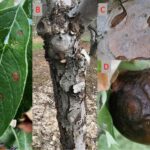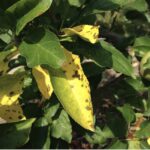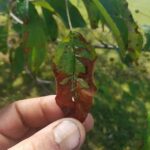Frogeye leaf spot, caused by the fungal pathogen, Botryosphaeria obtusa, has been quite prevalent this year, probably due to the combination of potential (and realized) crop loss and our cool, wet spring. This is the same fungus that causes cankers on the tree, along with black rot of apple fruit (Fig. 1).
Frogeye leaf spot gets its name from the concentric pattern of light brown to tan center portions of the leaf spot ringed by a darker margin. Infection is believed to start around petal-fall with small, discolored specks appearing where the fungus has infected and invaded the leaf. As the fungus continues to grow, the specks enlarge, forming small (1/8 to 1/4 inch diameter) spots; these develop a light center surrounded by one or more darker brown rings. Extensive spotting of leaves initially causes chlorosis (Fig. 2) followed by early leaf loss. Both attached and fallen, infected leaves develop black pustules (pycnidia) on the upper leaf surface (Fig. 1). These pycnidia help to distinguish frogeye leaf spots from similar spots caused by spray injury or other pathogens. These leaf spots serve as a warning that the spray program being deployed is not adequately protecting the tree; growers seeing frogeye leafspot should anticipate viewing black rot on fruit, and cankers on branches and stems, later in the growing season.
Other forms of leaf spotting can result when spores of apple scab or juniper rust germinate on more scab and rust resistant apple cultivars (Fig. 3). This is termed a hypersensitive response, and describes the death a few plant cells to protect the many, and results in the leaf compartmentalizing the invading pathogen. The invading rust fungus soon dies due to the host defense response, but the plant cells killed or damaged by the germinating spores leave their mark, and can provide an entry points for other leaf spotting fungi or saprophytes. Some rust infected spots may develop characteristic orange, pinpoint spots to distinguish them from other (scab or powdery mildew) pathogens.
Also be aware that some causes of leaf spotting may be due to captan injury (Fig. 4). Captan by itself rarely causes foliar phytotoxicity on apples, and only rarely does so on fruit. Unfortunately, due to the multitude of pests growers face (often happening at the same time), tank mixes are used; it is the combination of all the products in the tank that results in captan phytotoxicity. Spray oil, and/or adjuvants that are commonly used in the formulation of emulsifiable concentrations (ECs) and suspension concentrates (SC) can solubilize captan and allow it to move through the protective waxes on both fruit and leaf surfaces. This damage isn’t just limited to captan: Sulfur and/or liquid-lime sulfur can cause damage when applied ahead of hot weather whereas copper tends to cause phytotoxicity during cooler weather or under acidic tank mix conditions. All can be phytotoxic if mixed with oil sprays or their application in any order overlaps by 10 to 14 days.
Managing Frogeye Leaf Spot
Combining cultural and chemical management are critical for controlling of frogeye leaf spot, and a season-long fungicide program is recommended especially on those varieties that are highly susceptible to B. obtusa in all its forms (Fig. 5). Earlier in the season, mancozeb provides excellent control. Later on, captan and ziram are recommended during summer covers, supplemented with systemic fungicides like Flint Extra, Luna Sensation, Merivon, Pristine, and some DMI fungicides such as Inspire Super and Cevya are effective against the disease if disease pressures are high or other pathogens require management, as well.
The pathogen overwinters in bark, cankers, and mummies (from infected fruit, or hanger-ons from chemical thinning). Dead shoots and cankered limbs, regardless of the cause, should be removed and destroyed, as B. obtusa is an opportunistic pathogen and a fairly effective saprophyte that can colonize and reproduce on this tissue the following spring.
- Figure 1. A. Frogeye leaf spot; B. Cankered stem, photo by Patty McManus; C. Erumpent pustules visible from older canker produce spores that cause frogeye leaf spot, black rot and cankering; D. Black rot of fruit.
- Figure 2. Frogeye can cause chlorosis and defoliation.
- Figure 3. Unsprayed apple showing rust resistant spots, and defense responses to scab and powdery mildew.
- Figure 4. Captan injury.
- Figure 5. Variety differences in black rot susceptibility.
Figure 5. Variety differences in black rot susceptibility. Dr. Alan Biggs did an excellent evaluation that is available here: https://www.researchgate.net/publication/234007515_Relative_Susceptibility_of_Selected_Apple_Cultivars_to_Fruit_Rot_Caused_by_Botryosphaeria_obtusa




